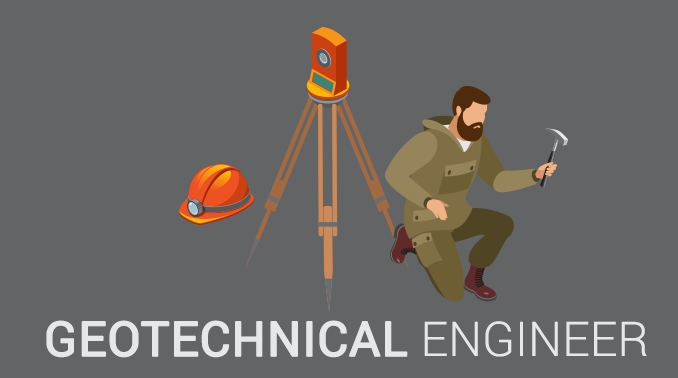Unknown Facts About Geotheta
Geotheta - The Facts
Table of ContentsThe 10-Second Trick For GeothetaThe Geotheta StatementsExcitement About GeothetaAll About GeothetaSome Known Questions About Geotheta.

They conduct site examinations, accumulate examples, carry out lab examinations, and analyze data to assess the viability of the ground for construction projects - Geo Tech Engineer. Based upon their searchings for, geotechnical designers give recommendations for foundation layout, slope security, retaining structures, and mitigation of geotechnical risks. They work together with various other specialists, such as engineers, structural designers, and construction teams, to guarantee that geotechnical considerations are integrated into the overall project layout and application
By examining the actions and buildings of dirt and rock, they can determine potential geotechnical threats such as landslides, dirt settlement, or slope instability. Their knowledge helps protect against failings or accidents that can threaten lives and building. Right here are some comprehensive duties and duties of a geotechnical engineer: Site Examination: Geotechnical engineers conduct website investigations to collect data on subsurface problems.
They interpret the data to comprehend the buildings and habits of the dirt and rock, including their stamina, permeability, compaction characteristics, and groundwater problems. Geotechnical Analysis and Design: Geotechnical designers examine the data collected during site investigations to examine the stability and suitability of the website for building projects. They do geotechnical computations and modeling to review aspects such as bearing capacity, negotiation, slope security, side planet pressures, and groundwater flow.
What Does Geotheta Do?
Foundation Layout: Geotechnical engineers play an important function in designing foundations that can securely support the desired structure. They analyze the soil problems and load demands to identify the appropriate foundation type, such as shallow structures (e.g., footings), deep structures (e.g (https://www.storeboard.com/geotheta)., stacks), or specialized techniques like dirt renovation. They think about aspects such as negotiation limits, birthing ability, and soil-structure interaction to develop optimum foundation layouts
They review building and construction strategies, monitor site tasks, and perform area evaluations to validate that the design referrals are complied with. If unanticipated geotechnical concerns occur, they assess the scenario and offer suggestions for remediation or adjustments to the layout. Danger Evaluation and Reduction: Geotechnical engineers examine geotechnical risks and threats linked with the task site, such as landslides, liquefaction, or dirt erosion.

Partnership and Interaction: Geotechnical engineers work very closely with other specialists entailed in a task, such as architects, architectural engineers, and building and construction groups. Efficient interaction and partnership are necessary to integrate geotechnical considerations into the general job layout and construction process. Geotechnical designers offer technical experience, solution questions, and ensure that geotechnical requirements are satisfied.
The 7-Minute Rule for Geotheta
Below are some sorts of geotechnical engineers: Foundation Engineer: Foundation designers specialize in creating and evaluating structures for structures. They analyze the dirt conditions, load needs, and site characteristics to figure out the most proper foundation kind and design, such as superficial structures, deep foundations, or specialized methods like heap structures.
They examine the elements affecting slope security, such as soil residential or commercial properties, groundwater conditions, and slope geometry, and create techniques to protect against incline failures and minimize dangers. Earthquake Designer: Quake engineers specialize in analyzing and developing frameworks to stand up to seismic forces. They analyze the seismic risk of a website, review soil liquefaction possibility, and establish seismic layout criteria to guarantee the safety and resilience of structures throughout earthquakes.
They carry out area screening, collect examples, and evaluate the accumulated data to define the dirt residential properties, geologic formations, and groundwater problems at a site. Geotechnical Instrumentation Designer: Geotechnical instrumentation engineers concentrate on tracking and determining the behavior of dirt, rock, and frameworks. They install and maintain instrumentation systems that check aspects such as Full Report dirt settlement, groundwater degrees, incline motions, and architectural displacements to examine efficiency and provide very early warnings of potential issues.
The smart Trick of Geotheta That Nobody is Talking About
They conduct examinations such as triaxial tests, consolidation tests, straight shear examinations, and permeability tests to gather data for geotechnical analysis and design. Geosynthetics Engineer: Geosynthetics engineers concentrate on the layout and application of geosynthetic materials, such as geotextiles, geogrids, and geomembranes. They use these materials to enhance soil stability, strengthen inclines, offer water drainage services, and control disintegration.
They tend to be investigative people, which indicates they're intellectual, reflective, and inquisitive. They are interested, methodical, reasonable, analytical, and sensible. Some of them are also social, meaning they're kind, charitable, participating, individual, caring, practical, empathetic, tactful, and friendly - Geo Tech Engineering.
In the office environment, geotechnical designers utilize specialized software devices to carry out calculations, develop layouts, and examine data. They prepare reports, review task specs, communicate with customers and group members, and coordinate task activities. The workplace setting gives a conducive atmosphere for research, analysis, and partnership with other experts associated with the project.
Not known Factual Statements About Geotheta
They often visit job websites to conduct site investigations, examine geotechnical conditions, and gather data for analysis. These sees involve taking a trip to various places, occasionally in remote or tough terrains. Geotechnical designers might do soil tasting, conduct examinations, and display building and construction activities to ensure that the geotechnical facets of the task are being applied correctly.
Geotechnical engineers likewise function in specialized geotechnical laboratories. In these centers, they perform experiments, perform examinations on soil and rock examples, and evaluate the engineering residential properties of the products. Geotechnical lab designers work extensively in these settings, handling screening devices, operating tools, and tape-recording data. They team up with various other laboratory team to make sure precise and dependable screening outcomes.